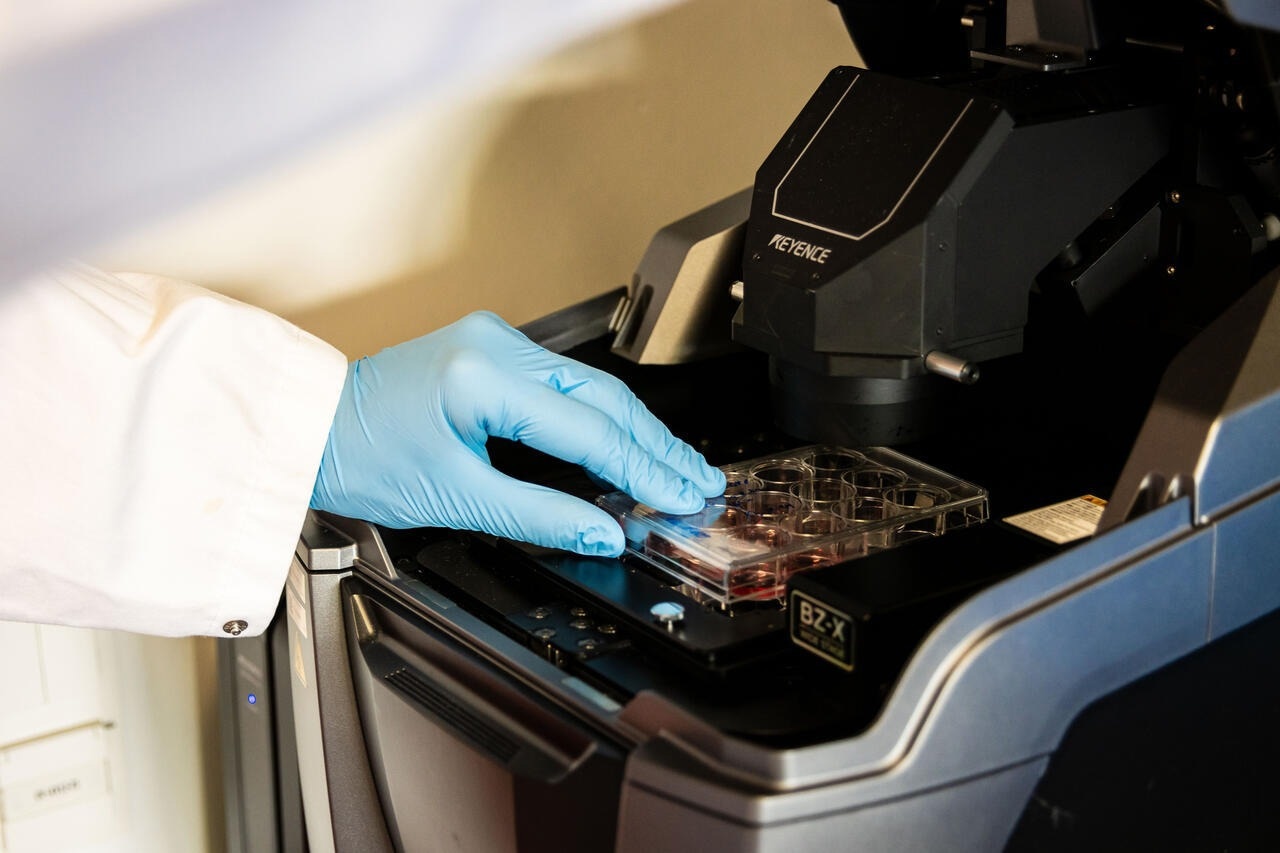Reviewed by Danielle Ellis, B.Sc.Sep 25 2024
A team from the Max Delbrück Center's Hübner and Diecke Labs demonstrated the genetic differences between human and non-human primate hearts. The study, published in Nature Cardiovascular Research, identifies evolutionary adaptations in human hearts and sheds new light on cardiac disease.
 A cell plate with cultured cardiomyocytes (cardiac cells) in inserted into a microscopy beneath the lens. Image Credit: Felix Petermann, Max Delbrück Center
A cell plate with cultured cardiomyocytes (cardiac cells) in inserted into a microscopy beneath the lens. Image Credit: Felix Petermann, Max Delbrück Center
Humans and chimps are 98–99% genetically similar. What, then, explains the differences? Over the years, researchers have demonstrated that gene expression regulation - when, where, and to what extent genes are turned on - is largely responsible for our divergent evolutionary paths.
Researchers from Professor Norbert Hübner's Cardiovascular and Metabolic Sciences Lab and Dr. Sebastian Diecke's Pluripotent Stem Cells Platform at the Max Delbrück Center have discovered surprising differences in gene expression in human and non-human primate hearts.
The study, led by Dr. Jorge Ruiz-Orera and published in the journal Nature Cardiovascular Research, identifies adaptations in gene regulation that distinguish human hearts from those of their closest evolutionary relatives. It also warns against extrapolating findings from animal to human hearts.
One of the most surprising findings was how gene regulation in the human heart differs so much from other primates.”
Dr. Jorge Ruiz-Orera, Computational Biologist, Max Delbrück Center
Most mammalian hearts are anatomically similar.
He added, “But we have many unique evolutionary innovations in terms of gene regulation or translation of proteins.”
The researchers discovered hundreds of genes and microproteins - tiny proteins previously identified in human organs but whose function has largely remained unknown - in human hearts but not in those of other primates, rats, or mice.
“Many of these human genes and microproteins are also abnormally expressed in heart failure, which suggests they could play important roles in cardiac function and disease and may present new targets for therapy,” Ruiz-Orera added.
Comparing Gene Transcription and Translation
The team examined heart tissue from humans, rats, and mice that had been stored for use in the lab’s earlier studies, as well as heart tissue from chimpanzees and macaques that had been taken from Dr. Ivanela Kondova’s biobank at the Biomedical Primate Research Centre in Rijswijk, Netherlands.
The scientists first mapped and measured the RNA molecules from heart tissues using RNA sequencing, which gave them a thorough understanding of gene expression in various species. Then, using Ribo-seq, they sequenced RNA fragments that were actively being translated in each cell, concentrating particularly on the RNA regions that were being translated into proteins.
This revealed which genes create functional proteins. By combining data from these technologies, the team generated the most comprehensive resource on gene and protein activity in human and non-human primate hearts.
Additionally, the researchers studied how genes are expressed during human and other primate heart development using induced pluripotent stem cell-derived cardiomyocyte (iPSC-CM) cell cultures as a model. Since they can be produced from adult primate skin cells that have been reprogrammed to resemble embryos, iPSC-CMs are a valuable model.
These cells develop into cardiomyocytes, the fundamental heart cell type, allowing researchers to examine them at various developmental stages.
According to Ruiz-Orera, the finding that certain microproteins, which are encoded in the genome by segments of DNA known as small open reading frames (ORFs), are selectively expressed or translated in human heart cells at various developmental stages raises the possibility that some of these genetic components could have evolved particularly to satisfy the needs of the human heart. (ORFs are not categorized as genes since they do not have the traditional characteristics of genes that code for proteins.)
He stated, “Our hearts have different energy demands compared to those of smaller primates like macaques, who have much faster heart rates. This difference seems to be reflected in the regulation of genes related to energy production in the heart. These evolutionary adaptations may also be linked to our bipedalism, lifestyle, and diet.”
Over 1,000 species-specific genomic adaptations were found by the team, including 504 microprotein coding regions and 551 genes that are exclusive to human hearts. Of these, 76 genes were discovered to be shared by humans, other primates, and mammals; however, these genes only evolved to be expressed in the heart of the human species.
Implications for Heart Disease and Use of Animals
The findings point to a potential role for these genes and microproteins in the development of cardiac diseases and provide a new target for therapeutic intervention. The researchers demonstrated how dysregulated these human-specific genes and microproteins are in conditions such as dilated cardiomyopathy.
The study also brings up significant concerns about studying the genetics of human cardiac disease using animals like mice.
“Our findings suggest that the differences between species could sometimes result in misleading results. There are many genes expressed in the human heart that simply aren't expressed in the hearts of other species,” Ruiz-Orera noted.
For instance, the human heart expresses the SGLT1 gene. However, in rats, mice, and non-human primates, it is only expressed in the kidneys. According to Ruiz-Orera, dual inhibitors of SGLT1 and SGLT2 have been demonstrated to lessen heart failure, despite the fact that its precise function in the heart is still unknown. However, testing such therapies in these models won't teach researchers much because it is not expressed in the hearts of other animals.
He concluded, “It highlights the importance of considering evolutionary context in medical research.”
Source:
Journal reference:
Ruiz-Orera, J., et. al. (2024) Evolution of translational control and the emergence of genes and open reading frames in human and non-human primate hearts. Nature Cardiovascular Research. doi.org/10.1038/s44161-024-00544-7